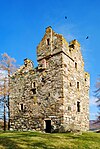Cap-house
Appearance

A cap-house (sometimes written cap house or caphouse) is a small watch room, built at the top of a spiral staircase, often giving access to a parapet on the roof of a tower house or castle. They provided protection from the elements by enclosing the top of the stairway, and sometimes incorporated windows or gun loops. They were built in various forms, including square turrets, simple boxes, or small houses with gabled roofs, which were sometimes large enough to provide accommodation for a look-out.[1][2][3][4][5][6]
Cap-houses were an authentic feature of the design of medieval and early-modern tower houses in Scotland, and were a frequent element used in the later Scottish Baronial architecture.
Gallery
[edit]Medieval and early-modern cap-houses
[edit]-
Knock Castle, Aberdeenshire, showing the cap-house above the entrance
-
Plunton Castle, with a gabled cap-house at the top of the stair wing (shown on the right)
-
Rusco Tower, with a gabled cap-house on the right, giving access to a parapet around the main roof
-
Barholm Castle's large cap-house, on the left
-
Sauchie Tower's cap-house, on the left, is hexagonal
-
Balvaird Castle's cap-house, in the middle
-
Fatlips Castle's cap-house, on the left, was renovated in 2013
-
Carsluith Castle's gabled cap-house, on the right
Nineteenth-century Scottish Baronial cap-houses
[edit]-
Balmoral Castle, with the Royal Standard of Scotland flying from a flagpole mounted on the roof of its cap-house
-
Scrabo Tower has a conical cap-house above its spiral staircase, with conical turrets on the other three corners
-
Friars Carse has a circular cap-house giving access to the roof of its tower
See also
[edit]- Turret—a tower that projects vertically from the wall of a building
- Bartizan—an overhanging projection from the wall of a building
- Garret—an attic or top floor room in the military sense; a watchtower from the French word garite
References
[edit]- ^ Lindsay, Maurice (1994). The castles of Scotland (2 ed.). Constable. p. 469. ISBN 9-780094-734302.
- ^ Maxwell-Irving, Alastair M. T. (2014). The Border Towers of Scotland 2: Their evolution and architecture. Stirling: Alastair M. T. Maxwell-Irving. p. 320. ISBN 9-781907-931376.
- ^ Gifford, John (1996). The Buildings of Scotland: Dumfries and Galloway. London: Penguin Books. p. 578. ISBN 9-780140-710670.
- ^ Toy, Sidney (1966). The Castles of Great Britain (4 ed.). London: Heinemann Educational Books. p. 201.
- ^ Pevsner's Architectural Glossary. New Haven: Yale University Press. 2018. p. 40. ISBN 9-780300-223682.
- ^ Stevens Curl, James; Wilson, Susan (2016). Oxford Dictionary of Architecture (3 ed.). Oxford University Press. p. 146. ISBN 978-0-19-967499-2.











